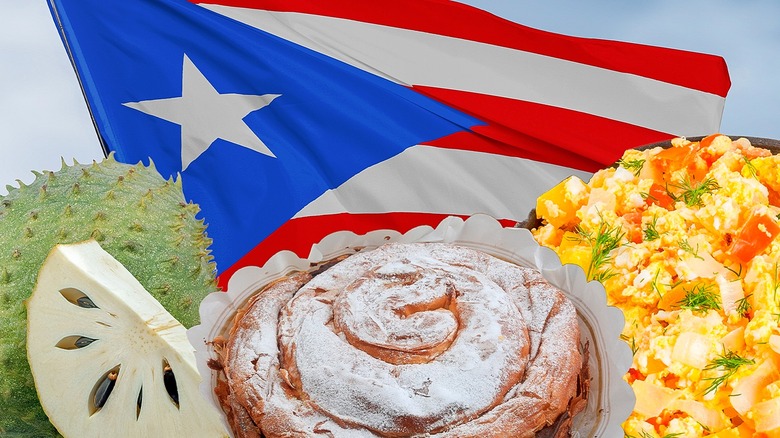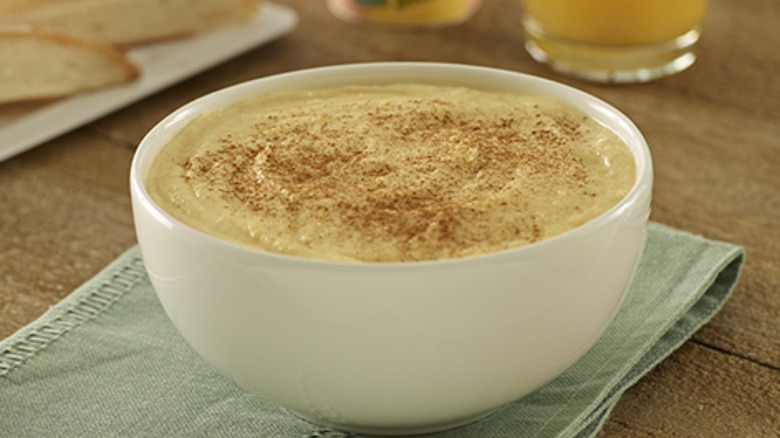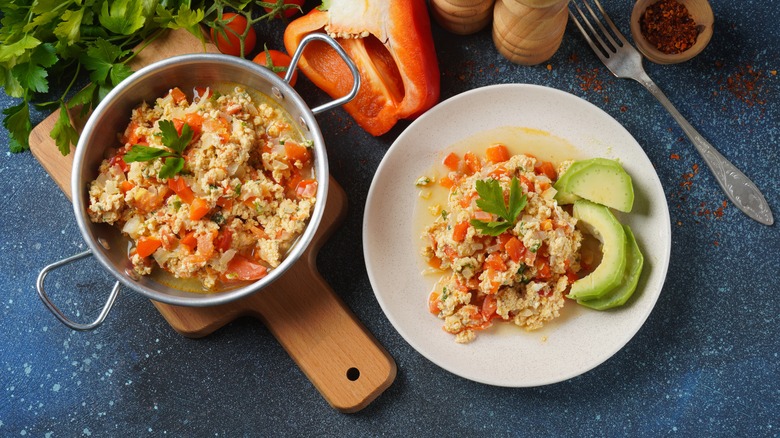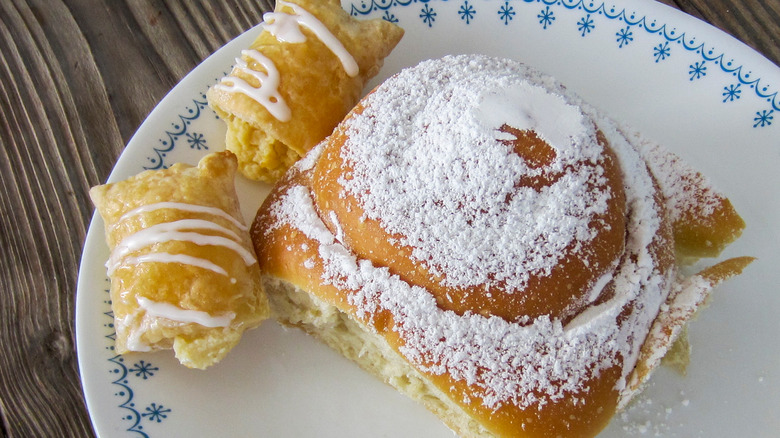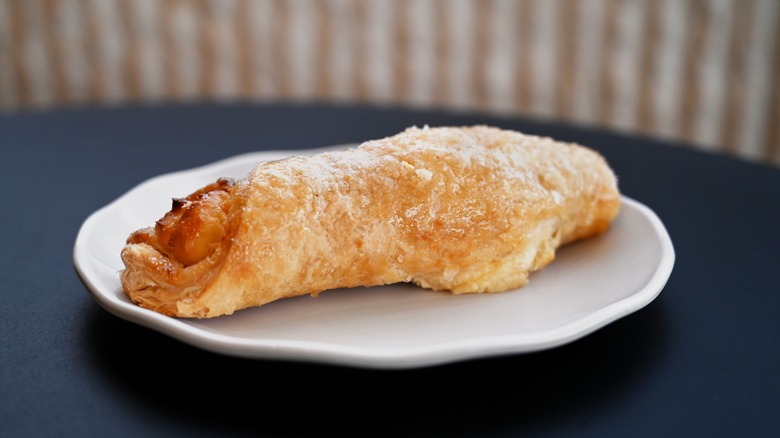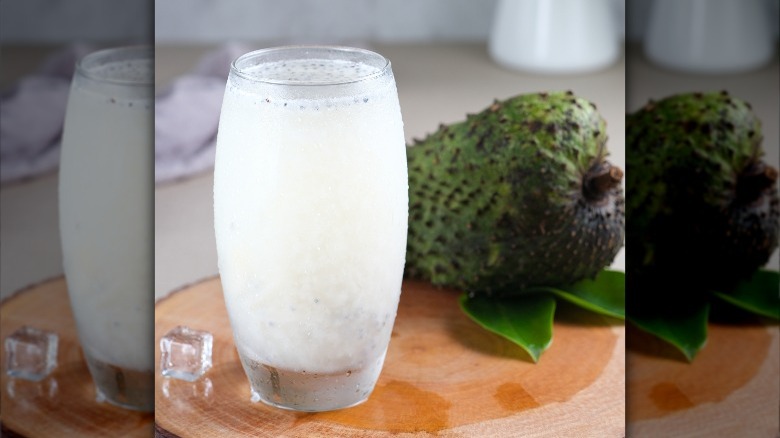5 Common Puerto Rican Breakfast Foods
At first glance, the breakfast menus at the Puerto Rican versions of McDonald's and Burger King, as well as at the popular Puerto Rican chain Meson Sandwiches, don't look too different from the breakfasts you'd find at any American fast food restaurant. At Mickey D's, you'll still find McGriddles, hotcakes, and hash browns (although, oddly enough, no McMuffins) while at BK, its Croissan'wiches, breakfast burritos, and French toast sticks are the order of the day. Meson, too, offers various combinations of eggs with ham, bacon, or sausage, plus a token veggie platter.
If you take a closer look, you'll notice some differences, including a greater variety of breakfast sandwiches as well as the fact that porridge is featured more prominently. These differences aren't just found at fast food restaurants, since Puerto Rico — like any other place — has its favorite breakfast foods.
While there doesn't seem to be any such thing as a "full Puerto Rican" along the lines of a "full English" (or Scottish) or Canadian lumberjack breakfast, there are certain foods that are characteristic of a morning meal in that island-slash-not-quite-state. Not only do most of the following items appear on the aforementioned fast food menus, but they're also something people enjoy at home. Some are savory, some are sweet, and some could go either way, but all of these Puerto Rican breakfast foods are something you should try at least once in your lifetime – or more, if you're lucky enough to live near a restaurante boricua with a.m. hours.
Crema
Here in the U.S., oatmeal isn't seen as a particularly exciting breakfast option even when it's dressed up in a hipsterish guise such as steel-cut chai latte overnight oats with crème brûlée topping. If you find it on a fast food menu at all, it will often include add-ons such as maple syrup and fruit, since even the health-conscious customer may pass by the plain stuff.
In Puerto Rico, however, porridge (or crema) is a popular breakfast food, even when unadorned. Puerto Rican Mickey D's and BK serve straight-up Quaker Oats, while Meson Sandwiches offers both oatmeal and cornmeal mush in fruit-free versions.
A wide selection of hot cereal mixes is also available for make-at-home breakfasters. These include crema de arroz (cream of rice), crema de farina (cream of wheat), crema de maiz (cream of corn), avena (oatmeal), and even porridge flavored with coconut. Cremas may be topped with butter and cinnamon, and all of the aforementioned fast food menus depict theirs made the latter. Fruit is also added at times, but it isn't considered de rigueur.
Revoltillo
If you were cooking a big breakfast at home for friends and family, the last thing you'd want someone to describe it as would be a revolting mess. The Spanish word "revoltillo," while it actually does mean "mess," is used in Puerto Rico to describe a breakfast that is as tasty as it is hearty. This not-at-all revolting (albeit slightly messy) dish consists of scrambled eggs plus everything but the kitchen sink.
Sausages, ham, bacon, shrimp, onions, avocados, tomatoes, peppers ... all of this and more might find its way into a revoltillo. The Chick-fil-A blog, in fact, once published a revoltillo recipe that called for using its own sausage patties and hash browns. (What, no chicken nuggets? There's no reason to leave those out.) While revoltillo seems to be more of a make-at-home, clean-out-the-fridge breakfast, Puerto Rican Burger King does list a "Revoltoso" sandwich on its menu that consists of a revoltillo-style omelet on a bread roll topped with ham, cheese, and sliced tomatoes.
Mallorca rolls
Pan de Mallorca is the tweener of Puerto Rican breakfast foods, since depending on the filling (or lack thereof), it can be sweet, savory, or somewhere in between. The bread takes its name from the Spanish island where it was born, but it's been a Puerto Rican favorite for the past century.
The dough for Mallorca rolls is made with a small amount of sugar as well as eggs for added richness, while the finished product is frequently finished off with a dusting of powdered sugar. Even with this sweet topping, the bread is often employed as a sandwich roll, as is the case with the ham- and cheese-filled Mallorca breakfast sandwiches sold by Meson Sandwiches and Puerto Rican Burger King.
Burger King caters to those who prefer sweeter Mallorcas, too, as it also sells them with nothing but butter. While this ingredient itself isn't exactly sweet, it allows the eater to focus more on the brioche-like flavor of the roll and its sugary topping. Sweeter Mallorcas, however, may be filled with jam or guava and cream cheese then paired with a mug of hot chocolate.
Quesitos
While many Puerto Ricans start their day with savory fare, others opt for a more continental-style breakfast consisting of a cup of cafe con leche (coffee with milk) accompanied by a pastry. The pastry of choice for many is the quesito, which is also a Spanish word meaning small piece of cheese. The cheese in this case is cream cheese, which is sweetened to make a filling similar to the one you might find in a cheese danish. The filling might also be flavored with jam, guava paste, red bean paste, almond paste, or dulce de leche.
One thing that differentiates quesitos from danishes, however, is the fact that the filling is enclosed in a roll of flaky puff pastry. Quesitos can also be glazed with honey or sugar syrup, which adds to the crunch.
While this breakfast treat is not out of the realm of the home baker, especially if frozen puff pastry is used, it's the kind of thing you'll also find at a Puerto Rican bakery. Neither McDonald's nor Burger King have quesitos on the menu at present, but Meson Sandwiches does offer this popular pastry.
Guanabana and quenepa
Puerto Ricans are lucky enough to live in a tropical climate where fruits like guavas, mangoes, and pineapples grow in abundance, and you might see any or all of these on a Puerto Rican breakfast table. Two other items that may be found in the fruit bowl, however, are less familiar here on the mainland than they are in Puerto Rico: guanabana and quenepa.
Guanabana, a fruit that's also known as soursop, has a sweet and tangy flavor like sugary pineapple with a touch of strawberry and lime. If you can't find fresh fruit, Goya produces canned guanabana juice, which can be enjoyed on its own or used to make batidos de guanabana (smoothies).
Quenepas, on the other hand, look like limes but taste like they've also got some lychee in their DNA. (No surprise, since these fruits are related.) For breakfast, quenepas are best consumed fresh or in the form of juice, but for a postprandial libation, they can also be used to infuse rum.
